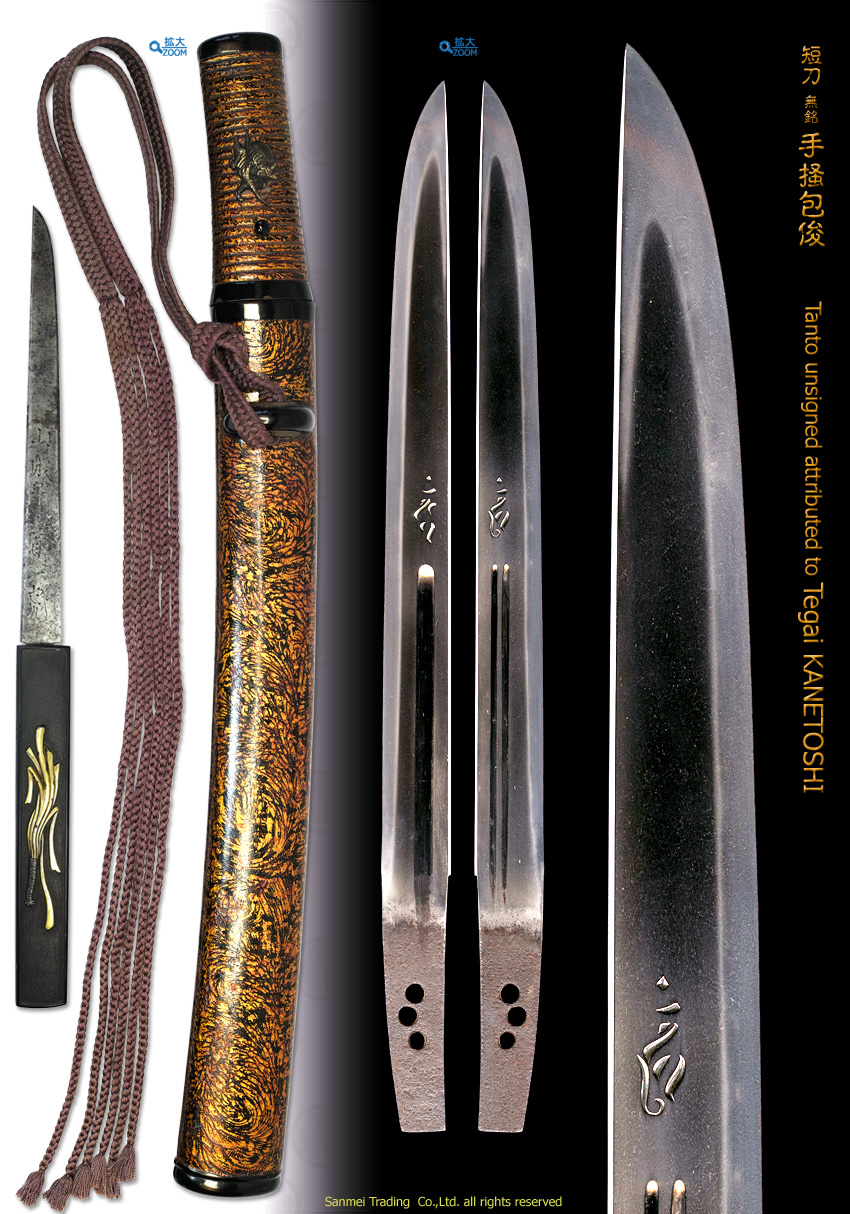with) Golden seaweed lacquered design AIKUCHI style tanto Koshirae
Length of cutting edge 28.5cm Inward curvature Width of base 25.2mm Thickness of base 5.9mm
There is a groove Bo-hi that is chiselled half-way into Nakago and a Sanskrit character (Fudo-Myouou) Bonji in front and the back side is chiselled with Homa-chopsticks with (Aizome-Myouou) Bonji character. (click HERE for higher resolution image of the entire blade)
Forging(Hada): Forging is well-woven Masame-hada mixing with partial indication of Mokume burl. Fine steel gives off moist skin impression covering with incredibly fine Nie minute martensite glitter that generates Ji-nie sparkling reflection as well as isolated quenching area of Yubashiri on both Hiraji-surface and the back ridge of Mune side also.
Temper(Hamon): Hamon is incredibly fine Nie hard metal granules base, starts with irregular line of Yakidashi where shows some Hotsure flay indication then wide Suguha. Quenching line of Suguha generates superfine bright Nie and the most deepest Nioi mist attaches in the interior of temper where Ashi and YOU activities are perceived.
Temper of tip(Boshi): Boshi is wide in temper to form gentle Suguha along less swelling Fukura then creates a small circle then deeply turns back.
Tang(Nakago): Nakago is in UBU originally unsigned. Three peg holes of Mekugi-ana. Katte-agari (slightly slanting right) filemarks. Cutting edge is sharp whereas the back ridge of Nakago is round-contoured. Heel shape is KIRI flat-square.
Among Yamato regions, the most ancient lineage Senjuin 千手院 appeared end Heian era (1100s) then major lineages of Touma 当麻, Tegai 手掻, Housho 保昌 and Shikkake 尻懸 occurred to form the five major lineages in Yamato province during Kamakura - Nanbokucho period.
Each group belonged to an individual Buddhist temple and exclusively worked and made for it's monk soldiers.
The Tegai 手掻 was the most biggest, powerful group that belonged to Todaiji-temple 東大寺. The founder KANENAGA 包永 appeared Shouou era(1288-) and they set up their artier studio nearby 転害門 Tegai-mon west gate of Toda-ji temple.
The name of Tengai 転害 had been converted into Tegai 手掻 - a name of sword maker group. Even present time, the name of town Tegai-cho 手貝町, Higashi-Kanenaga-cho 東包永町 or Nishi-Kanenaga-cho 西包永町 remain near the Tegai-mon gate 転害門.
In sword maker scholarship, the swords and makers are distinguished due to it's workmanship between Tegai 手掻 and Sue-Tegai 末手掻 (on bafore Nanbokucho period is called Tegai 手掻 and those ones on after Muromachi is called Sue-Tegai 末手掻).
According to the Nihonto Meikan, KANETOSHI 包俊 who belonged to Tegai 手掻 was a pupil of KANEYUKI 包行 and being active Nanbokucho period (ca 1381-).
Among five lineages of Yamato, Workmanship of Tegai 手掻 shows reportedly the most strongest/brightest Nie both on surface and temper and it is convincing that this Tanto is given an expert opinion as a work of indivisual name of smith KANETOSHI 包俊 in Tegai 手掻 lineage.
This tanto emits incredibly bright of fine Nie that creates similar Soushu-oriented workmanship in vogue of those days like the famed smith Kaneuji 兼氏 who came from same Tegai 手掻 lineage.
This tanto comes with an antique from Edo period Golden seaweed design AIKUCHI style tanto Koshirae
(click HERE for entire Koshirae in FRONT/ HERE for BACK side and HERE for each metal fitting)
- All fitting of Fuchi/Kashira,Koikuchi, Kurikata, Ura-kawara and Kojiri : made of buffalo horn
- Kozuka : kenjo-Noshi design 献上熨斗図, Shakudo, Nanako-ji surface, Gold/silver Iroe, unsigned
- Menuki : Samurai warriors design, Shakudo Yobori, Iroe
Fresh polish/Condition scale: excellent - very good (using a scale of mint-excellent-very good-good-fair-poor).
reference data:
Honma Junji/Ishii Masakuni, Nihonto Taikan, Yuzankaku, 1975




